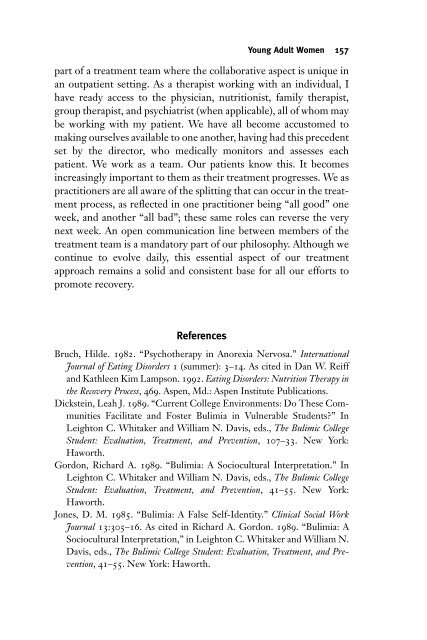Eating Disorders - fieldi
Eating Disorders - fieldi
Eating Disorders - fieldi
You also want an ePaper? Increase the reach of your titles
YUMPU automatically turns print PDFs into web optimized ePapers that Google loves.
part of a treatment team where the collaborative aspect is unique in<br />
an outpatient setting. As a therapist working with an individual, I<br />
have ready access to the physician, nutritionist, family therapist,<br />
group therapist, and psychiatrist (when applicable), all of whom may<br />
be working with my patient. We have all become accustomed to<br />
making ourselves available to one another, having had this precedent<br />
set by the director, who medically monitors and assesses each<br />
patient. We work as a team. Our patients know this. It becomes<br />
increasingly important to them as their treatment progresses. We as<br />
practitioners are all aware of the splitting that can occur in the treatment<br />
process, as reflected in one practitioner being “all good” one<br />
week, and another “all bad”; these same roles can reverse the very<br />
next week. An open communication line between members of the<br />
treatment team is a mandatory part of our philosophy. Although we<br />
continue to evolve daily, this essential aspect of our treatment<br />
approach remains a solid and consistent base for all our efforts to<br />
promote recovery.<br />
References<br />
Young Adult Women 157<br />
Bruch, Hilde. 1982. “Psychotherapy in Anorexia Nervosa.” International<br />
Journal of <strong>Eating</strong> <strong>Disorders</strong> 1 (summer): 3–14. As cited in Dan W. Reiff<br />
and Kathleen Kim Lampson. 1992. <strong>Eating</strong> <strong>Disorders</strong>: Nutrition Therapy in<br />
the Recovery Process, 469. Aspen, Md.: Aspen Institute Publications.<br />
Dickstein, Leah J. 1989. “Current College Environments: Do These Communities<br />
Facilitate and Foster Bulimia in Vulnerable Students?” In<br />
Leighton C. Whitaker and William N. Davis, eds., The Bulimic College<br />
Student: Evaluation, Treatment, and Prevention, 107–33. New York:<br />
Haworth.<br />
Gordon, Richard A. 1989. “Bulimia: A Sociocultural Interpretation.” In<br />
Leighton C. Whitaker and William N. Davis, eds., The Bulimic College<br />
Student: Evaluation, Treatment, and Prevention, 41–55. New York:<br />
Haworth.<br />
Jones, D. M. 1985. “Bulimia: A False Self-Identity.” Clinical Social Work<br />
Journal 13:305–16. As cited in Richard A. Gordon. 1989. “Bulimia: A<br />
Sociocultural Interpretation,” in Leighton C. Whitaker and William N.<br />
Davis, eds., The Bulimic College Student: Evaluation, Treatment, and Prevention,<br />
41–55. New York: Haworth.









